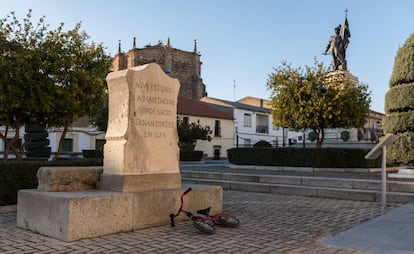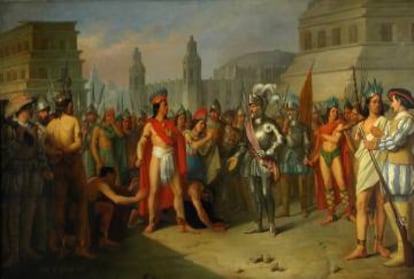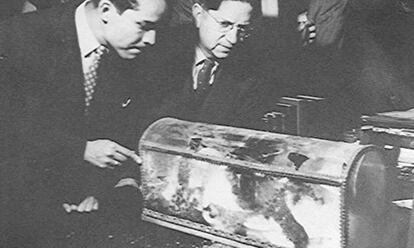Hernán Cortés’ remains languish in a safe in Spain amid political standoff over conquistador’s legacy
Former Extremadura regional premier Guillermo Fernández Vara announced a year ago that the relics, kept privately for decades, would be put on public display, but the current conservative administration has them stored in an archive


In the film Raiders of the Lost Ark (1981) the mythical Ark of the Covenant ends up in the warehouses of a U.S. military base. In the case of the relics of Hernán Cortes that are kept in Spain (his ashes, clothes, documents and fragments of urns), these have rested in a safe at the Historical Archive of Cáceres for over a year. They are not on display to the public. They have been stored there since the former premier of the Spanish region of Extremadura, Guillermo Fernández Vara, presented them at a press conference on July 16, 2023, along with the book that recounts their transfer to Spain in 1946, El Secreto (The Secret).
The agreement between the donors of the remains, the Gutiérrez-Colomer family, and the regional administration consisted of their exhibition in the church of San Martín, in the Extremadura municipality of Medellín, where the conquistador was born in 1486. However, everything is now at a standstill. The current regional government of the conservative Popular Party (PP) has not offered any explanation, although it has announced that there will soon be “an important meeting related to the subject.”
Tomás García, official chronicler of Medellín and president of the Medellín Historical Association, is shocked: “It seems that politicians are having kittens about paying due tribute to this important figure. And even more so with the current situation [outgoing Mexican president Andrés Manuel López Obrador issued a letter to Spain demanding an apology for the excesses committed during the Spanish conquest of the Americas].”
The story began when Spanish pharmacist Leonardo Gutiérrez-Colomer met historian Alberto María Carreño in Mexico in 1946, who told him a secret: the body of the conquistador was hidden in a niche in the Church of Jesús, in the center of the Mexican capital. All Spanish ambassadors, he told him, had been involved in the concealment since Mexican independence in 1821 to prevent the remains being destroyed. However, the breakdown of relations between the two nations as a result of the reception of Republicans in Mexico after the Spanish Civil War (1936-1939) allowed the secret to be revealed.
Cortés’ remains were finally exhumed on November 25, 1946, by a group of Mexican experts to verify the truth of the claim. Upon opening the niche, they discovered a cedar box containing a lead urn, a glass urn, and Cortés’ body, whose head rested on a cushion. His remains were covered by a white shroud and tied with a velvet ribbon.
Carreño then gave Gutiérrez-Colomer a piece of silk, a piece of broken glass from the urn, a piece of lead, a piece of Camagüey lace, a piece of black velvet ribbon and a sealed envelope with a silver stamp bearing the initials AMC (Alberto María Carreño), which confirmed that it contained “dust from the bones of Hernán Cortés. December 9, 1946.” The purpose of the donation was to transfer the historical remains to Spain.

But Gutiérrez-Colomer was never able to fulfil the task. He tried unsuccessfully to hand the relics over to the authorities of the Francisco Franco dictatorship. After an endless administrative and academic labyrinth and numerous refusals, he gave up. He would keep them at home. Over the years, Cortés’ relics were passed down through the generations until they reached the pharmacist’s grandchildren (Blanca, Mercedes, and Leonardo). They decided that it was time to hand them over. They contacted Matilde Muro, author of El Secreto and president of the Union of Bibliophiles of Extremadura. Muro, in turn, asked for an appointment with the then-regional premier, Guillermo Fernández Vara, of the Spanish Socialist Workers’ Party (PSOE).
“They came to see me in 2021,” Fernández Vara recalls, “and gave me a series of relics and a dossier, including a sealed envelope. I sent everything to the Historical Archive of Cáceres for collation and research. When scientists and historians confirmed to me that everything was correct, I made it public. I was worried that it was a hoax. In fact, no one in my administration knew about it.”

Fernández Vara then agreed with the family that the remains would be permanently displayed in the Medellín Church of San Martín, together with a portrait of Gutiérrez-Colomer. “The idea was to put them in a chapel, in a worthy place, that could be visited, as well as creating a small information center that would explain the whole story. But now everything has stopped,” says Fernández Vara.
The chronicler García is equally bemused. “We are waiting for the regional government to release the remains. The idea was to transfer them to Medellín with military and civil honors, which they deserve, but there is no support from politicians. The presentation of the remains and the book was done poorly, with too much haste. It is true that it coincided with the formation of the [regional] government, but that is not how things are done. Neither did the president of the Provincial Council speak, and I was not even invited. It was all done in a hurry.” In García’s opinion, the current conservative leaders of the regional government are “afraid of being seen with Cortés. I do not understand anything. He is a fundamental historical figure.”
Muro, for her part, maintains that the display of the relics “would represent Spanish gratitude to Mexico for the exiles it welcomed, but also the history of five centuries ago, when Cortés created a state, established order, and imposed rules. It is about highlighting vestiges that Mexico is ashamed of having, and that Spain did not want to receive.”
Muro explains that when Fernández Vara revealed the donation of the relics, artist Antonio Serrano Bulnes was approached to design a project for their exhibition, but that this never took place. Fernández Vara confirms this: “The PP shelved everything that came from me, but you can’t be afraid of history or stop it. This is a historical fact.”
Muro also recalls that “the day the relics were made public coincided with the announcement by [Extremadura regional premier] María Guardiola of the formation of a government with [far-right party] Vox, which forced Vara to change the subject and start making statements right there and then. Politics came into play, as is normal. But the act of presentation was silenced and no one paid any attention.” The relics were returned to the safe of the Historical Archive of Cáceres.
On September 8 — Extremadura Day — Guardiola stated that “the history of Extremadura in the Americas had to be rescued.” The politician affirmed, says Muro, that “it was going to be a central axis of her policy and that she was preparing a magnificent project. We are all expectant. I hope that someone will assume the debt owed to Cortés and to Mexico for the way it welcomed the exiles.”
The Extremaduran regional government, like the mayor of Medellín, has refused to comment on the matter in recent weeks. “I hope that on Friday [October 4], when the King [Felipe VI] inaugurates the meeting of the Hispanic-American Academies of History in Trujillo, someone will approach him and say: ‘Your majesty, what are we going to do with what we have here? It is our history, the history of Extremadura, of Mexico, and of Spain,’” concludes Muro.
Sign up for our weekly newsletter to get more English-language news coverage from EL PAÍS USA Edition
Tu suscripción se está usando en otro dispositivo
¿Quieres añadir otro usuario a tu suscripción?
Si continúas leyendo en este dispositivo, no se podrá leer en el otro.
FlechaTu suscripción se está usando en otro dispositivo y solo puedes acceder a EL PAÍS desde un dispositivo a la vez.
Si quieres compartir tu cuenta, cambia tu suscripción a la modalidad Premium, así podrás añadir otro usuario. Cada uno accederá con su propia cuenta de email, lo que os permitirá personalizar vuestra experiencia en EL PAÍS.
¿Tienes una suscripción de empresa? Accede aquí para contratar más cuentas.
En el caso de no saber quién está usando tu cuenta, te recomendamos cambiar tu contraseña aquí.
Si decides continuar compartiendo tu cuenta, este mensaje se mostrará en tu dispositivo y en el de la otra persona que está usando tu cuenta de forma indefinida, afectando a tu experiencia de lectura. Puedes consultar aquí los términos y condiciones de la suscripción digital.
More information
Archived In
Últimas noticias
Welcome to the post-religion era: The idea of Christianity as the absolute truth has become obsolete
‘I thought you would like it’: The risky sexual practice popularized by TV shows and TikTok
The digitalization of tourism: ‘They promise experiences and gave us the worst possible one’
Mexican peso defies uncertainty with forecasts of a new period of stability in 2026
Most viewed
- Sinaloa Cartel war is taking its toll on Los Chapitos
- Oona Chaplin: ‘I told James Cameron that I was living in a treehouse and starting a permaculture project with a friend’
- Reinhard Genzel, Nobel laureate in physics: ‘One-minute videos will never give you the truth’
- Why the price of coffee has skyrocketed: from Brazilian plantations to specialty coffee houses
- Silver prices are going crazy: This is what’s fueling the rally









































